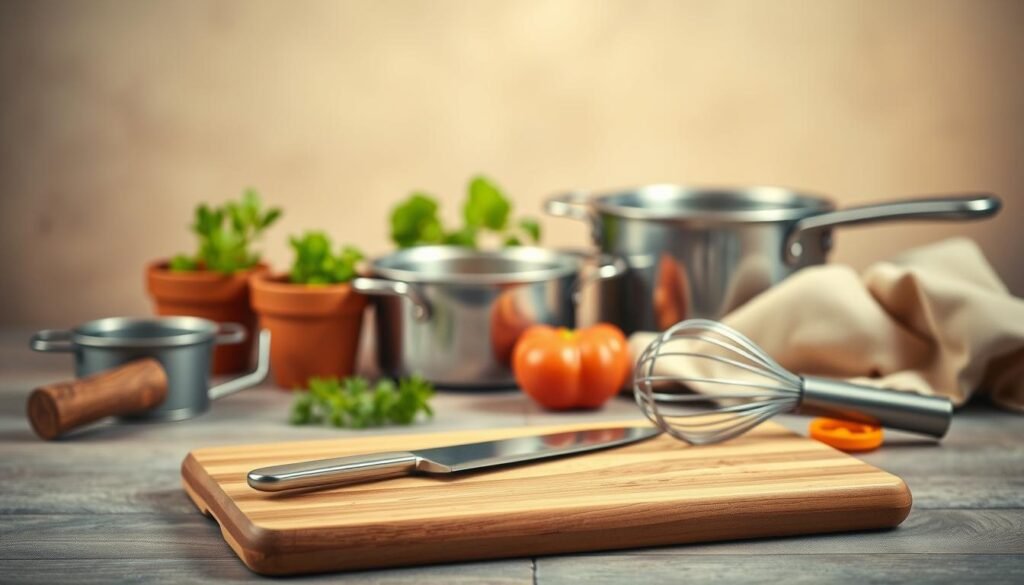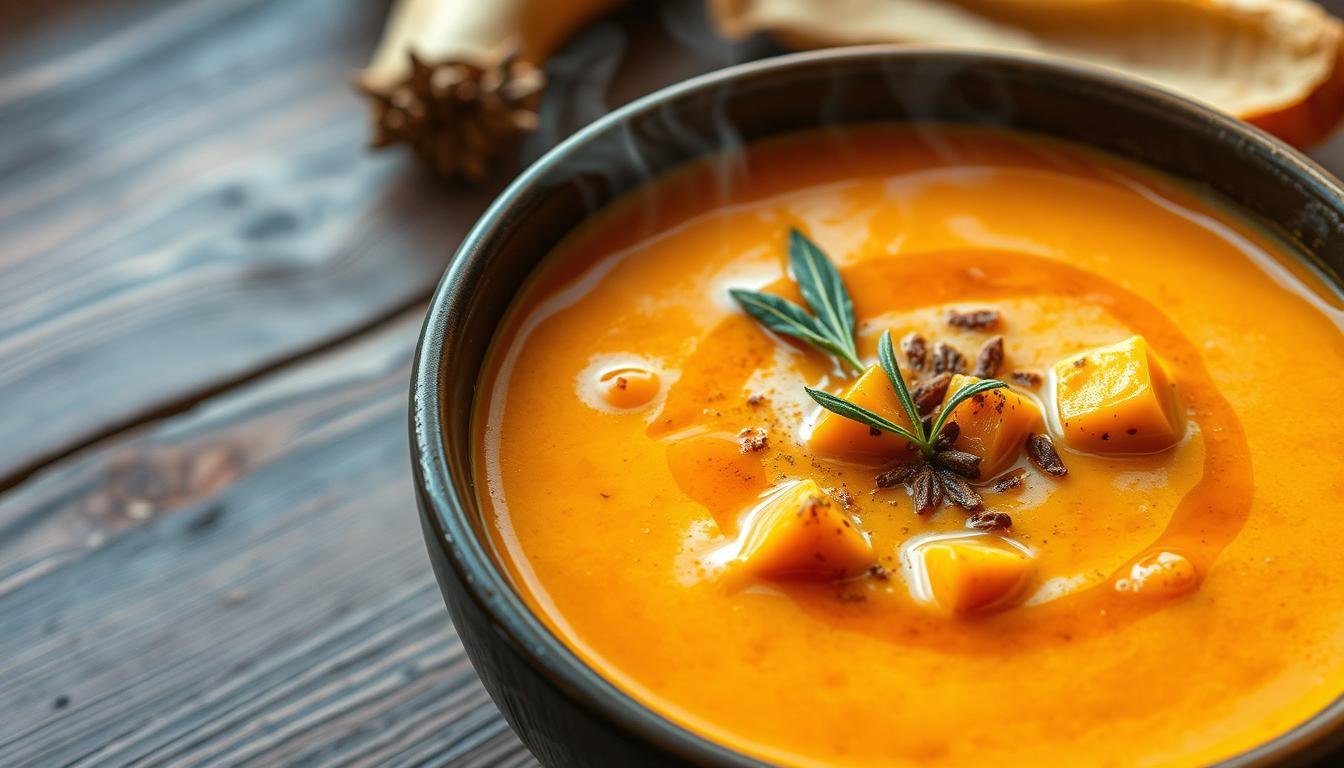Roasted Butternut Squash Soup
Have you ever wondered why roasted butternut squash soup is a fall favorite? It’s a velvety, warming dish that turns simple ingredients into a cozy bowl. It instantly takes you back to those crisp autumn evenings.
Fall soup recipes are more than just meals. They’re experiences that connect us to the season. Roasted butternut squash soup is the peak of autumn’s culinary delights. It offers a rich, creamy texture that wraps your taste buds in warmth.
This soup’s vibrant orange color and satisfying flavor capture the essence of fall cooking. Whether you’re an experienced chef or just starting out, this recipe will become your go-to for the season.
Key Takeaways
- Roasted butternut squash soup is the ultimate fall comfort food
- Simple ingredients create an incredibly rich flavor profile
- Perfect for chilly autumn evenings and family gatherings
- Easy to customize with various spices and garnishes
- Nutritious and packed with seasonal vegetables
What Makes Butternut Squash Perfect for Soup
Butternut squash is a star in fall and winter cooking. It turns simple soups into amazing dishes. Its sweet taste and creamy texture are perfect for cold weather.
This squash is also super healthy. It’s full of vitamins A and C. These vitamins make it great for soups, adding nutrition and a smooth texture.
Butternut squash is very versatile. It roasts well, getting sweet and caramelized. This makes it easy to make a fancy dish at home.
Cooks love butternut squash because it’s easy to work with. It’s great for beginners and experts alike. It takes flavors well, letting you get creative in the kitchen.
Choosing a fresh squash from a farmers’ market is best. It’s in season from early fall to winter. This makes it perfect for warm, comforting meals.
Quick Recomendation: Our blog is full of useful information to inspire you. If you are seeking a healthy way to prepare your meals, we recommend this Keto product
Essential Ingredients for Your Soup
Making a tasty roasted butternut squash soup begins with picking the right ingredients. Choose fresh, quality parts to highlight the squash’s rich flavors. A ripe butternut squash is key, giving your soup a creamy, sweet taste.
Some important ingredients turn your squash into a memorable dish. Onions and garlic add a deep aroma. Broth, whether vegetable or chicken, enriches the soup’s taste. Heavy cream or coconut milk adds a luxurious feel.
Seasoning is key to making your soup stand out. Use cinnamon, nutmeg, salt, and pepper to boost the squash’s natural sweetness. Fresh herbs like thyme or sage add depth. Olive oil is essential for roasting the squash, bringing out its caramelized flavors.
If you follow a special diet, many ingredients can be swapped. Vegetarians can use vegetable broth, and those avoiding dairy can choose coconut or almond milk. This soup is great because it’s flexible and meets many dietary needs.
How to Properly Roast Butternut Squash
Roasting butternut squash is key to a rich, flavorful soup. It brings out the squash’s natural sweetness and adds deep, caramelized notes. These enhance your butternut squash recipes.
Begin by picking a fresh butternut squash with smooth skin. Wash it well and cut it in half lengthwise with a sharp knife. Use a spoon to remove the seeds, making the inside ready for roasting.
Heat your oven to 425°F for the best roasting. Drizzle olive oil on the squash halves and sprinkle with salt and pepper. You can also add dried thyme or rosemary for extra flavor in your soup.
Put the squash cut-side down on a baking sheet covered with parchment paper. This method helps the squash caramelize and prevents sticking. Roast for 35-45 minutes until it’s tender and golden-brown.
After roasting, let the squash cool for a few minutes. The skin will come off easily, making it simple to scoop out the soft, flavorful flesh. This roasted squash is perfect for your delicious butternut squash recipes.
Kitchen Equipment You’ll Need

To make a tasty homemade soup, you need some key kitchen tools. Start by picking the right gear to make butternut squash soup easy and fun.
A top-notch chef’s knife is a must. It’s for chopping butternut squash and other veggies safely and quickly. Choose one with a good grip and a sharp blade that can cut through tough squash skin.
Next, you’ll need a good roasting pan. A sturdy pan helps caramelize the squash and brings out rich flavors. Ceramic or cast-iron pans are best for even heat when cooking your soup ingredients.
For blending, you have two great choices. An immersion blender lets you puree right in the pot, making less mess. Or, a standard blender can make your soup smooth and creamy. Pick what feels best for you.
A big stockpot with a thick bottom is key for simmering and mixing your soup. Stainless steel or enameled cast iron pots are great for heat control and avoiding burns.
Lastly, don’t forget basic measuring cups, a cutting board, and wooden spoons. With these, you’re all set to make a delicious butternut squash soup in your kitchen.
Step-by-Step Guide to Roasted Butternut Squash Soup
To make a tasty roasted butternut squash soup, start by heating your oven to 425°F. Cut the butternut squash in half and remove the seeds and pulp. Then, drizzle with olive oil and sprinkle with salt and pepper.
Roast the squash for 45-50 minutes until it’s tender and slightly caramelized. This step makes the squash sweeter, adding richness to your soup. After it cools, scoop out the flesh and save it.
In a big pot, cook diced onions and garlic until they smell good. Add the roasted squash, vegetable broth, and a bit of cream. Blend until smooth with an immersion blender. Add nutmeg and cinnamon to deepen the flavor.
Your soup is almost done. Check the taste and add more cream or coconut milk if it’s too thick. Serve hot, topped with a dollop of cream and fresh herbs for a fancy look.
Customizing Your Soup’s Flavor Profile

Fall soup recipes are a canvas for creativity, and butternut squash is a prime example. With just a few tweaks, your roasted butternut squash soup can take on a new life.
Spice enthusiasts can add a kick with cayenne pepper or smoked paprika. For a Mediterranean flair, rosemary and thyme are great choices. Cumin and coriander add an earthy warmth that pairs well with butternut squash’s natural sweetness.
Adding unexpected ingredients can take your soup to the next level. Coconut milk adds a creamy texture with a hint of tropical flavor. Roasted garlic enhances the soup’s depth, while maple syrup adds a touch of sweetness perfect for fall.
Try exploring different global flavors. An Indian twist might include garam masala and yogurt. A Mexican version could feature chipotle peppers and cilantro. Your kitchen becomes a place for culinary adventure.
The best butternut squash recipes are those you make your own. Trust your taste and create a soup that you love.
Best Garnishes and Toppings
Make your creamy squash soup stand out with the right garnishes. A few toppings can turn a good meal into an unforgettable one. Start with a swirl of heavy cream or Greek yogurt. It adds a luxurious feel and looks great.
Crunchy toppings add a nice contrast to the smooth soup. Toasted pumpkin seeds add a nutty crunch that pairs well with the squash. Crispy sage leaves bring a herbal taste that’s perfect for autumn. Croutons add a fun texture that makes each spoonful exciting.
Want to add more flavor? Try sprinkling smoked paprika or crispy bacon bits on top. These not only look good but also add new tastes to your soup. Fresh herbs like chives or parsley can also brighten the dish and add color.
Try different toppings to find your favorite mix. With these garnishing tips, your autumn comfort food will be a hit.
Storage and Reheating Tips

Your delicious roasted butternut squash soup needs the right care to keep its amazing taste. Storing winter warmers like this soup is key. Follow these tips to keep your meal fresh and delicious.
First, refrigerate the cooled soup. Put it in an airtight container and keep it in the fridge for 4-5 days. A tip: leave an inch at the top for expansion if you freeze it later.
Freezing is great for meal prep. Cool the soup and put it in freezer-safe containers or bags. Butternut squash soup can be frozen for 2-3 months. Don’t forget to label the container with the date.
Reheating needs gentle care. Warm refrigerated soup slowly over medium-low heat, stirring often. If it’s frozen, thaw it in the fridge first. Avoid high heat to keep the soup smooth.
When reheating, add a bit of broth or water to get the right consistency. This helps if the soup thickened while stored. Stir well and taste before serving for the best flavor and temperature.
Pairing Suggestions for a Complete Meal
Your roasted butternut squash soup needs the right sides for a cozy meal. Try crusty artisan bread or warm garlic focaccia. These breads add a nice texture and soak up the soup’s flavors.
For those who love meat, grilled chicken or roasted turkey medallions are great. Vegetarians can enjoy quinoa salad or roasted veggies. The goal is to find sides that enhance the soup’s taste without overpowering it.
Wine lovers might like a crisp Chardonnay or light Pinot Noir with the soup. If you prefer not to drink, apple cider or herbal tea is perfect. These drinks add warmth and make the meal even more enjoyable on cool nights.
When making your meal, remember to balance textures and flavors. Choose sides that complement the soup’s cozy, autumn feel. This way, you’ll have a complete and satisfying meal.
Common Troubleshooting Tips

Making the perfect creamy squash soup can be tricky. But, most problems are simple to solve. If your soup isn’t quite right, don’t panic. Just remember these easy fixes.
If your soup is too thick, add warm chicken broth or water slowly. Stir well until it’s just right. If it’s too thin, add roasted butternut squash puree or a cornstarch mix to thicken it.
Seasoning is key to a great soup. If it tastes flat, add a bit of salt, lemon juice, or nutmeg. These can make a big difference. Taste and adjust as you go.
Lumpy soup can be annoying. Use an immersion blender to smooth it out. Or, blend it in batches in a regular blender. Just be careful not to splash hot liquid.
Remember, the more you make soup, the better you’ll get. Use these tips to make your creamy squash soup amazing. Soon, you’ll be a pro at it.
Seasonal Variations and Adaptations
Your roasted butternut squash soup can change with the seasons. In autumn, use classic roasted butternut squash with cinnamon and nutmeg. Winter is the time to add parsnips or carrots for a heartier soup.
Spring is when you can make your soup lighter. Add asparagus or spring peas. Use coconut milk instead of heavy cream for a vegan option. Summer is for a cold version, topped with fresh herbs from your garden.
Every season brings a new twist to your soup. Try using local, fresh ingredients from farmers markets. This way, your butternut squash soup can highlight the best of each season.
Conclusion
Your journey to make the perfect roasted butternut squash soup is more than cooking. It’s a celebration of fall soup recipes that warm your heart. This winter warmer turns simple ingredients into a culinary masterpiece.
As you try different variations, remember cooking is about creativity. Each batch of roasted butternut squash soup has its own story. It connects you with seasonal traditions and comforting flavors.
Your kitchen becomes a cozy sanctuary when you make this soup. Whether for family, friends, or yourself, it’s a chance to slow down. Embrace the season, try new ingredients, and make this soup a favorite in your kitchen.
So, grab your favorite soup pot and a beautiful butternut squash. Start your delicious cooking adventure. Your taste buds will thank you for this incredible winter warmer.
Quick Recomendation: Our blog is full of useful information to inspire you. If you are seeking a healthy way to prepare your meals, we recommend this Keto product






